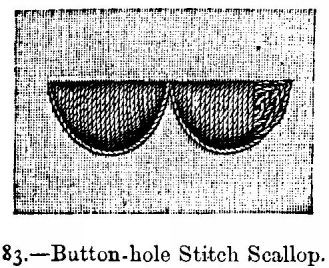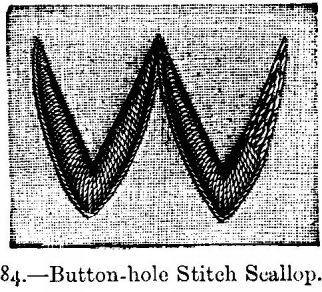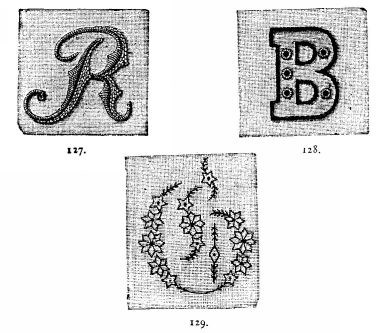 полная версия
полная версияBeeton's Book of Needlework


ILLUSTRATIONS 80 & 81 show the ladder stitch, often used in ornamental embroidery. Trace first the outlines as seen in illustrations; mark also the cross stitches between the outlines, so that the first touch the outlines only at both ends. The outlines are embroidered in overcast stitch or double overcast; the material is cut away underneath the ladder stitch between the outlines.
We have now shown the different kinds of stitches used in embroidery; the following illustrations show them used for different patterns.




ILLUSTRATIONS 82 TO 85 (Different Button-hole Stitch Scallops).–These scallops are prepared as above described. Take care to have the stitches even and regular; the scallops must be wide in the centre and very fine at both ends.
ILLUSTRATIONS 86 & 87 (Button-holes and Eyelets).–This kind of embroidery is used only in round or long patterns. Trace first the outline of the hole, cut away a small round piece of material, not too close to the outlines (when the button-hole is very small merely insert the point of the scissors or a stiletto into the material), fold the edge of the material back with the needle, and work the hole in overcast stitch, inserting the needle into the empty place in the centre and drawing it out under the outline. Some button-holes are worked separately; sometimes they are in a row; if so, take care to begin to work each button-hole at the place where it touches the next. In the following button-holes the outside must be traced double, so as to reach as far as the next one, but each button-hole is finished at once. Illustration 86 shows a button-hole worked round in button-hole stitch, 87 an eyelet-hole worked in overcast.




ILLUSTRATIONS 88 & 89.–Shaded button-holes are worked like the others, only they are prepared, as can be seen in illustration 89, so as to mark the thickness. The stitches must gradually get narrower or wider, and be worked very close to each other.

ILLUSTRATIONS 90 & 91 (Two Leaves in Raised Satin Stitch).–In a leaf like the one seen in 90 work first the outline and veining in overcast stitch; work one half of the leaf in satin stitch, and the other half between the overcast outline and veining in back stitch. The stem of a leaf is always worked last.


ILLUSTRATIONS 92 & 93 (Two Leaves in Satin Stitch and Point de Plume).–For leaves like the one seen in 93 begin with the veinings, then work the inner points, then the outer ones, and lastly the raised spots in the centre. The leaf seen in 92 is worked, one half in point de plume, the other half in back stitch or point d'or.


ILLUSTRATION 94.– The outline of this leaf is embroidered in overcast stitch; the open-work veining consists of eyelets; one half of the leaf is worked in back stitch, the other half in a kind of satin stitch worked without chain stitches underneath; the stitches are worked across the leaf, leaving between two stitches an interval as wide as the stitch itself. The next row is then worked in these intervals, and each stitch begins half-way up the one before and after it.



ILLUSTRATIONS 95 to 97 (Leaf in Raised Embroidery).–This kind of embroidery is particularly beautiful, as it is worked separately and sewn on the material with an outline in very fine cotton, this produces the shade seen in 95 (see also illustrations 98 to 113). For such leaves work first one half in overcast and satin stitch (illustration 96); the other half is worked on a separate piece of material (see illustration 97); cut away the material along the overcast outline, and fasten it on the foundation material along the outline which forms the veining on illustration 96.



ILLUSTRATIONS 98 TO 100 show a similar leaf; both halves are worked separately (see 99); the centre is worked in open lace stitch. The latter (see No. 100) is traced, then make ladder stitches across, work the outlines in overcast stitch, and cut away the material underneath the ladder stitch. The cross stitches are then worked in darning stitch with very fine cotton wherever two threads meet.

ILLUSTRATION 101 (Blossom in Satin Stitch).–The eyelet is worked in overcast stitch, then work the upper part of the blossom all in one piece as far as the beginning of the veining, thence the blossom is worked in two halves.


ILLUSTRATIONS 102 & 103 (Blossom in Satin Stitch).–The raised centre of this flower is formed by a bead, over which the embroidery is worked. When the leaves have been worked one after the other, place a bead in the centre, left free in such a manner that one hole lies on the material, and work over the bead by inserting the needle into its upper hole, then underneath the material, drawing it out above the material close to the bead, and so on (see 103).

ILLUSTRATION 104 (Star Pattern in Satin Stitch).–The centre, which forms a wheel, is worked first. Draw the threads across the circle marked by an outline; in the centre they are wound round, always taking one thread on the needle and leaving the next thread under the needle, as can be seen in 122 on the half-finished pattern. The material underneath the wheel is only cut away when the rest of the pattern has been embroidered.

ILLUSTRATIONS 105 & 106 (Patterns in Back, Satin, and Ladder Stitches).–The small star in the centre of No. 105 is worked in point de reprise.


ILLUSTRATION 107 (Flower in Satin Stitch).–The fine veinings are worked with fine black silk in point russe, which renders the effect of the flower very beautiful.


ILLUSTRATIONS 108 & 109 (Rose in Satin Stitch).–No. 109 shows one petal larger than full size. The outer circle only is prepared with chain stitches underneath, so as to appear raised; the inner circles are worked flat. The centre of the rose is embroidered in open work.

ILLUSTRATION 110 (Embroidered Heartsease).–For the knotted stitch see No. 75. for the point croisé see 71 and 72.

ILLUSTRATION 111 (Flower in Raised Satin Stitch).

ILLUSTRATION 112 (An Ear of Corn in Point de Minute).


ILLUSTRATIONS 113, 114, & 116 (Bluebell in Raised Satin Stitch).–This flower is worked partly in separate pieces, as has been described. Illustration 116 shows the raised part stretched out flat. When it is finished it is fastened down along the dotted line on No. 114, which shows the inner part of the flower.

ILLUSTRATION 115 (Flower in Point de Minute).–This stitch is here worked over a thick foundation of chain stitches. For raised patterns it looks very well.


ILLUSTRATIONS 116 & 117 (Flower worked in Appliqué).–To work in appliqué, two materials, either similar or different, are needed. You can work either in appliqué of muslin on muslin, or of muslin on net, or of net on net. Muslin on Brussels net is the prettiest way of working in appliqué; we will therefore describe it: the other materials are worked in the same manner. Trace the pattern on the muslin, fasten the latter on the net, and trace the outlines of the pattern with very small stitches work them in overcast stitch with very fine cotton, taking care not to pucker the material. The veinings are worked in overcast. When the pattern has been embroidered cut away the muslin round the outlines with sharp scissors, so that the net forms the grounding (see No. 117). The greatest care is required in cutting out the muslin to avoid touching the threads of the net.

ILLUSTRATIONS 118 & 119 (Narrow Borders).–It will be easy to work these borders from the above instructions. Observe only that on border 118 the outer row of scallops is worked first, then the button-hole stitch row, and the rest afterwards. The spots are edged all round in knotted stitch. The wheels in the centre of the eyelets of No. 119 are worked with very fine cotton in loose button-hole stitch; they are wound round with the cotton in a second row.


ILLUSTRATIONS 120 TO 122.–Three strips of insertion, which are worked nearly like the ladder stitch. For No. 120, in tracing the outlines, make two small knots at short distances by winding the cotton four times round the needle, as can be seen in illustration; the windings are held down with the thumb of the left hand, draw the needle through, and a knot is formed. The outlines are worked in button-hole stitch only when all the knots have been made, and then the material is cut away underneath. Illustration 121 is a variety of the slanting ladder stitch.
Illustration 122.–The cross threads are worked in two rows in the common herring-bone stitch, as can be seen by the black lines on the illustration. The straight lines at the top and at the bottom are worked in double overcast; lastly, the wheels are worked in a row as described for the star pattern, No. 104.


ILLUSTRATIONS 123 To 129 (Embroidered Initials).–To learn to work initials the Roman characters are the easiest to begin with. They must be traced and prepared like other embroidery in satin stitch, only the chain stitches underneath must not be too thick: it would take away the shape of the letters. All depends on the fineness and regularity of the stitches; they must be worked in overcast stitch. Work from left to right, and the letter when completed must look rather like raised printing than like embroidery. Gothic letters are much more difficult to work on account of the many flourishes; it requires great practice in needlework to embroider them well.
Illustration 123.–The small black dots are worked in black silk on the thick parts of the letter: the fine strokes are covered with cross threads of black silk.
Illustration 124.–The outlines of the letter and the fine strokes are worked in black silk.
Illustration 125.–This letter is embroidered in raised satin stitch and point de plume.
Illustration 126.–This letter is worked in back stitches, over which are worked at regular distances cross stitches of black silk.
Illustration 127.–Letter in satin and back stitch.
Illustration 128 to be worked in overcast and double overcast.

ILLUSTRATION 129.–Letter G in point russe with black silk.

ILLUSTRATION 130 (Embroidered Figures).–They are worked like the letters in point de plume and overcast; the dots are worked in knotted stitch.
EMBROIDERY
EMBROIDERY PATTERNS
[In working the following Embroidery Patterns it will be found advisable to trace the design clearly upon tracing-paper with a sharp-pointed lead pencil. The pattern thus traced must be perforated with a fine needle in a succession of tiny holes, at the rate of about twenty to the inch. Those ladies who possess a sewing-machine will find no difficulty in accomplishing this. Several thicknesses of paper can be perforated at the same time, if required, by any ordinary machine. To transfer the traced and perforated design to the fabric to be embroidered, it is only necessary to rub a small quantity of powder blue through the holes.]
131.–Insertion in Embroidery.
Material: Messrs. Walter Evans and Co.'s embroidery cotton No. 16.
This insertion is worked in raised satin stitch and buttonhole stitch. The outlines must first be traced and the space filled up with chain stitches. To work a leaf, begin at the point, working from right to left, making short stitches, and always inserting the needle close above the outline and drawing it out below. The holes left for the ribbon to pass through are worked in plain button-hole stitch, the dots are worked in raised satin stitch.

132.–Insertion in Embroidery and Stitching.
Materials: Messrs. Walter Evans and Co.'s embroidery cotton Nos. 10 and 16.
The veinings of this pretty insertion must be worked in overcast stitch (No. 68, Embroidery Instructions), the leaves and flowers in raised satin stitch, the scallops in button-hole stitch, and the outer edge of the leaves in back stitch (No. 70, Embroidery Instructions) with No. 10 cotton.

133.–Cravat End in Embroidery.
Materials: Muslin, cambric, or linen; Messrs. Walter Evans and Co.'s embroidery cotton No. 24, or fine black China silk.
This graceful design is worked in raised satin stitch (see Nos. 76 and 77, Embroidery Instructions) and back stitching, or point Russe. Black silk may be introduced at will, and the delicate leaves may be stitched in fine black silk, and the flowers embroidered in white, with the stamens in black silk.

134.–Basket Embroidered in Chenille.
Materials: A basket of fine wicker-work; 1 skein of black chenille, and 3 of blue chenille.
This small round basket measures seven inches across; it has a cover and two handles. The wicker is very delicately plaited, and is ornamented with a pattern in chenille which is very easy to work. Upon the cover, work in point Russe one large star in blue chenille, with the centre and outer circle in black. All round, work small stars in blue chenille, with a black stitch in the centre. The position of these stars is shown in our illustration. The basket requires no mounting; it is not even lined.

135.–Pattern for Collars and Cuffs in Embroidery.
Materials: Muslin, cambric or lawn; Messrs. Walter Evans and Co.'s embroidery cotton perfectionné No. 40.
Work the outer circle in long even scallops (see page 90 of Embroidery Instructions) in raised button-hole stitch; the spray of flowers is embroidered in raised satin stitch, the leaves in the same, and the rosebud calyx in tiny eyelet-holes. The centres of the roses are embroidered in open-work.

136.–Cravat End in Embroidery.
Materials: Muslin, Brussels net; Messrs. Walter Evans and Co.'s embroidery cotton No. 30.
Tack the traced muslin over the net and work the scallop of the inner edge; next the design in the centre must be worked in raised satin stitch (see No. 77 in Embroidery Instructions). The raised dots are also worked in satin stitch (see page 90 of Embroidery Instructions). Lastly, work the outer edging of round scallops and the lines of raised dots, and with a pair of embroidery scissors carefully cut away the muslin from the outer edge and from the leaves of the centre pattern.

137.–Embroidery Pattern for Collars, Cuffs, &c.
Materials: Linen; Messrs. Walter Evans and Co.'s cotton perfectionné No. 40.
This pretty star should be worked in fine overcast stitch (see No. 68 in Embroidery Instructions). The centre is worked in raised satin stitch leaves round a circle of button-hole stitch, in the middle of which a wheel is worked thus:–Slip the cotton under the thick edge and fasten it, then cross it over and back so as to make 8 bars, then twist the cotton twice round 1 bar; this will bring it to the centre; work over and under each of the bars until a thick dot is formed; fasten the cotton beneath this, and twist it twice round the bar opposite to the first one you worked, and finish off.

138.–Embroidery Covering for a Quilted Counterpane.
Materials: Cashmere, cambric muslin, or linen; Messrs. Walter Evans and Co.'s embroidery cotton No. 4.

This is an embroidery-pattern for a woollen or silk quilted counterpane. Such counterpanes generally have a lining which is turned back on the right side, and buttoned down at the point of each scallop. The pattern is a quilted counterpane of scarlet cashmere; the lining is of fine linen. Before embroidering it, make the points for the corners. The embroidery is worked in button-hole stitch, overcast, satin, and ladder stitch. It can also be worked on fine cambric or muslin, and then the embroidered pattern sewn on the piece of linen which forms the cover on the wrong side. Make the button-holes as seen on illustration, and sew on mother-of-pearl or china buttons.

139.–Embroidery Pattern for Ornamenting Collars, Cuffs, &c.
Materials: Muslin, cambric, or linen; Messrs. Walter Evans and Co.'s embroidery cotton No. 40.
This pattern is worked in satin stitch, point Russe, and point d'or on muslin, cambric, or linen; it is suitable for collars, or cravat ends, or handkerchief corners.
140.–Handkerchief in Embroidery
Materials: French cambric; Messrs. Walter Evans and Co.'s embroidery cotton No. 50.

Three rows of hem-stitching ornament this handkerchief; the pattern forms an insertion within the outer rows, the flowers are worked in raised satin stitch, with eyelet-hole centres (see No. 87 of Embroidery Instructions); the tendrils are worked in overcast stitch; three rows of raised dots, in groups of four, are worked on the inner side of the last row of hem-stitching. This pattern looks very handsome on a broad-hemmed handkerchief.
141.–Convolvulus Leaf Insertion.
Materials: Muslin; Messrs. Walter Evans and Co.'s embroidery cotton No. 20.

The convolvulus leaves are worked in raised satin stitch, the veinings and stems in overcast stitch, the eyelet-holes in slanting overcast stitch. (See No. 69 of Embroidery Instructions.)
142.–Insertion.
Materials: Muslin; Messrs. Walter Evans and Co.'s embroidery cotton No. 20.
This simple insertion is worked in raised satin stitch, the stems alone excepted; these are embroidered in overcast stitch.

143 and 144.–Two Patterns in Embroidery for Trimming Lingerie.
Materials: Messrs. Walter Evans and Co.'s embroidery cotton No. 20, and Mecklenburg thread No. 50.

These patterns are worked in point Russe and stitching; the spots in satin and knotted stitch. Illustration 143 is ornamented in the centre with lace stitches.
145 and 146.–Insertion.
Materials: Muslin; Messrs. Walter Evans and Co.'s embroidery cotton No. 16.
The two insertions, Nos. 145 and 146, are worked partly in satin stitch, partly in open-work embroidery, and are edged on either side with an open-work hem.

